Are you a Quiet Speculation member?
If not, now is a perfect time to join up! Our powerful tools, breaking-news analysis, and exclusive Discord channel will make sure you stay up to date and ahead of the curve.
They key to brewing successfully is to work with cards you love. My enduring fascination with Tarmogoyf and Blood Moon led me to develop a strategy that gets the most out of both cards. Last week, we saw the birth of TURBOGOYF and the deck's first draft. This article tracks the deck's development, which culminates in a build with Siege Rhino, and proposes a new take splashing Chalice of the Void.
(This article is the second in a two-part series on my experience designing Tarmogoyf/Blood Moon decks in Modern. If you haven't read part one, check that out first!)
[wp_ad_camp_1]
TURBOGOYF 2.0: Goyfblade
TURBOGOYF 1.0 grew enormous Tarmogoyfs while casting consistent, turn-two Blood Moons. The deck's second version followed suit, but also respected the deck's core.
I cut Simian Spirit Guide entirely and added three Sword of Light and Shadow. With all those artifacts to grow the Goyf, I ditched Pyrite Spellbomb. Two Chandra seemed like enough since I rarely wanted multiples, especially in openers.
The big innovation for this version was the sideboard black splash. I needed a way to deal with enemy Goyfs, as my absence of hard removal depended entirely on the fact that my Goyf would be bigger than anything I sat across from. Abrupt Decay best answers the beater, and black also allows Slaughter Games for combo decks like Grishoalbrand. I took the following list to a 60-man PPTQ last summer and lost in the Semifinals to Tribal Zoo.
[wp_ad_camp_1]
TURBOGOYF 2.0, by Jordan Boisvert
Testing Takeaways
 Even with sideboard Decays, playing against Tarmogoyf meant an uphill battle. Opposing Lhurgoyfs proved impossible to remove game one outside of Goyf+Bolt or a lucky Dismember, so I had to rely on Moons to keep them off the table. Unfortunately, basic Forest isn’t that hard for Tarmogoyf decks to find. Without Decays in the main, Twin also becomes very hard to beat game one, since they don’t care so much about Blood Moon, have counterspells to slow us down, and are difficult to interact with using only Lightning Bolt.
Even with sideboard Decays, playing against Tarmogoyf meant an uphill battle. Opposing Lhurgoyfs proved impossible to remove game one outside of Goyf+Bolt or a lucky Dismember, so I had to rely on Moons to keep them off the table. Unfortunately, basic Forest isn’t that hard for Tarmogoyf decks to find. Without Decays in the main, Twin also becomes very hard to beat game one, since they don’t care so much about Blood Moon, have counterspells to slow us down, and are difficult to interact with using only Lightning Bolt.
Three Slaughter Games was too many. We can easily Loot into a copy, and it only wins games outright in already favorable matchups (Ad Nauseam, Amulet Bloom, Living End, etc.). In others, Games exiles Splinter Twin or Wurmcoil Engine at best.
In addition to recurring Goyf and Huntmaster, Sword of Light and Shadow protected all our threats (besides Birds) from Lightning Bolt by growing them out-of-range. But three was also too many, since "Protection from white and from black" saves creatures from spells that Moon already cuts off in game one. The card is mostly useful for attrition wars, and the only attrition deck we might face that doesn't lose to Blood Moon is 8Rack, already a favorable matchup thanks to Goyf and Huntmaster.
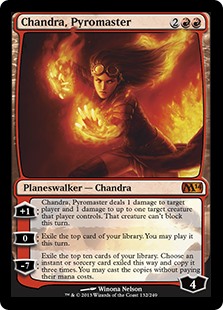 Chandra either secured a hard-lock with her +1 or drew cards. The extra cards were nice, but in those scenarios a threat would have won me the game, whereas Chandra would gradually draw me into victory, giving opponents a chance to find basics before I found an actual win condition.
Chandra either secured a hard-lock with her +1 or drew cards. The extra cards were nice, but in those scenarios a threat would have won me the game, whereas Chandra would gradually draw me into victory, giving opponents a chance to find basics before I found an actual win condition.
Finally, while a 6/7 or 7/8 or 8/9 Goyf was good for some laughs, he still "died to removal." In the situations where he’d beat up on a locked-down opponent, it wouldn’t have mattered if he’d been a mere 4/5; the game was already over. Getting too cute to grow him past a certain degree just wasn’t worth it.
TURBOGOYF 3.0: Jund Moon
Going forward, I decided to max Tarmogoyf out at 5/6. At this size, he survives Roast and Dismember, and beats everything not named Wurmcoil Engine (which he’d lose to even at 8/9) or Primeval Titan (which never resolves through Blood Moon) in combat.
The non-Twin, non-Goyf matchups that needed help were primarily of the aggressive variety (Zoo, Affinity, and Burn specifically). Mainboard Decay helped against all of these decks. A four Bolt/four Decay removal suite is extremely versatile and helps TURBOGOYF do a convincing BGx impression when a Moon eludes us. Black also gave us another early beater in Tasigur, the Golden Fang.
 I introduced Courser of Kruphix for his synergy with mana birds and Looting, his ability to draw us cards, the lifegain clause, and dat ass. He effectively replaced Chandra as a card advantage engine which also dealt damage. He dealt twice as much as Chandra per turn and drew the cards regardless, all while walling attackers.
I introduced Courser of Kruphix for his synergy with mana birds and Looting, his ability to draw us cards, the lifegain clause, and dat ass. He effectively replaced Chandra as a card advantage engine which also dealt damage. He dealt twice as much as Chandra per turn and drew the cards regardless, all while walling attackers.
Increasing the number of basic Forests was important for this build, since the most common line with Utopia Sprawl on turn 1 was to name black, then to fetch a red source and cast Blood Moon. More Forests meant a better chance of drawing them, and Courser rots in hand if we can’t pay his double green cost. Double green also activates Tasigur’s ability, and double red wasn't needed anymore (except for Faithless Looting + flashback) without Chandra. Naturally, the Molten Rains in the Sideboard had to be replaced for their prohibitive cost, making way for the invariably hideous (and hilarious) Stone Rain.
TURBOGOYF 3.0, by Jordan Boisvert
Testing Takeaways
Tasigur was fine when I had him, but underwhelming. He also synergized very poorly with Faithless Looting.
Additionally, I disliked the Coursers. Like Sword of Light and Shadow, they're decent in grindy settings, but Blood Moon already dominates those. There had to be superior options against aggro decks. Double green was also tougher to manage after a turn two Blood Moon than expected, meaning Courser would usually come down on turn four if at all. By then I needed a card in this slot that presented a lot of aggression, like an extra Tarmogoyf or Huntmaster. In searching for one, I even tried Goblin Rabblemaster, but his softness to Bolt was a major issue.
TURBOGOYF 4.0: Abzan Moon
Unfortunately, Jund colors allotted us but Obstinate Baloth for this role. I tried Thragtusk, but his five-mana cost conflicted with the Looting engine, which asks us to stop "ramping" at four mana. So, I looked into other colors.
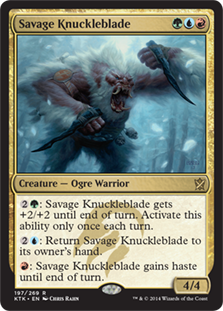 At first, I splashed blue over black for Savage Knuckleblade, also cutting two lands and two other spells (meta dependent) for a playset of Serum Visions. Visions is extremely powerful in Modern, and its library manipulation coupled with Faithless Looting to make the deck extremely consistent. Blue also opened up the possibility of counterspells (namely, Negate) from the sideboard. Unfortunately, RUG wasn’t good enough; without Abrupt Decay, the deck became too soft to Twin.
At first, I splashed blue over black for Savage Knuckleblade, also cutting two lands and two other spells (meta dependent) for a playset of Serum Visions. Visions is extremely powerful in Modern, and its library manipulation coupled with Faithless Looting to make the deck extremely consistent. Blue also opened up the possibility of counterspells (namely, Negate) from the sideboard. Unfortunately, RUG wasn’t good enough; without Abrupt Decay, the deck became too soft to Twin.
I went back to the Decays (once you go black...) and splashed white for the build’s final form, resulting in a fairly horrific-looking list. Siege Rhino is the four drop of my dreams, applying a ton of pressure, stonewalling aggressive strategies, and coming down for four mana as early as turn three; ideally, right after a Blood Moon!
White also gives us an old favorite of mine in Blood Moon decks: Ajani Vengeant. The planeswalker gains life, kills creatures that sneak in under Blood Moon, and most importantly, freezes our opponent’s basic land. Often, a Stone Rain effect is better than Ajani when we want one, but Ajani's versatility, and his ability to command an opponent's attention for fear of his ultimate, make him a better mainboard card. Still, running Ajani means stretching the manabase a little thinner and running less mana or threats, so I eventually dropped Vengeants from this build.
TURBOGOYF 4.0, by Jordan Boisvert
The sideboard also gets a makeover. Rhino makes Baloth obsolete, and Grafdigger's Cage is a concession to Company and Disciple of Griselbrand decks, many of which can survive a Blood Moon. Dismember offers utility against Twin, aggro, and Goyf decks, and Darkblast shines both in grindy matchups and against linear aggro decks. Kolaghan's Command gives us creature recursion while hosing Affinity, letting us scrap Ancient Grudge for something more universally applicable; for instance, against BGx, I cut the Rhinos and the Plains and become a Huntmaster-recursion deck with the inevitability of four Stone Rains and Blood Moon. Specific hosers like Creeping Corrosion will never allow these sorts of transformational plans.
Testing Takeaways
This Abzan Moon variant won me a respectable haul of boxes at GP side events and smaller tournaments, but I didn't love the deck's midrange playstyle enough to bring it to longer events last summer. I favored Monkey Grow for these, which paid off with an IQ win, but TURBOGOYF remained my weapon of choice for smaller metagames, as it crushed Twin, BGx, and just about any rogue aggressive strategy.
I consider Abzan Moon the natural evolution of Skred Red. On paper, it's a goodstuff Jund/Abzan hybrid that gives up targeted discard for Blood Moon as a trump in the midrange mirror. In practice, it's a hyper-reliable Moon machine and the best Goyf/Moon deck I've built yet.
A Return to Rituals: Chalice and RabbleRit
Day's Undoing drew me away from Tarmogoyf/Blood Moon decks to focus entirely on Delver variants. But as Modern became increasingly linear to Choke the storm of Grixis decks we've seen in the last few months, I started working on a core of TURBOGOYF that employs Ryuuta's beloved Rituals over Utopia Sprawl to enable Chalice of the Void.
RabbleRit, by Jordan Boisvert
Chalice Immunity
Outside of the sideboard Rending Volley, which can't be countered anyway, this deck doesn't run any one-drops. Resultantly, Chalice of the Void never hinders us and always at least annoys our opponents. Chalice seriously damages a plethora of Modern decks, including Burn, Infect, Living End, 8Rack, Affinity, and Delver.
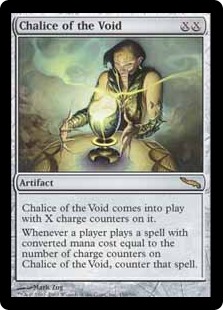 Considering disruption alone, Chalice is a real beating on turn one or two. Even against midrange decks like Grixis Control, the artifact turns off Serum Visions, Thought Scour, Lightning Bolt, Inquisition of Kozilek, Spell Snare, and Dispel. In Patrick Chapin's list from GP Charlotte, that's a whopping 15 integral cards! Add to that the fact that Grixis Control is stronger against Chalice than some other Modern options, like Restore Balance and Small Zoo, and you have a serious case for the card's playability in this format.
Considering disruption alone, Chalice is a real beating on turn one or two. Even against midrange decks like Grixis Control, the artifact turns off Serum Visions, Thought Scour, Lightning Bolt, Inquisition of Kozilek, Spell Snare, and Dispel. In Patrick Chapin's list from GP Charlotte, that's a whopping 15 integral cards! Add to that the fact that Grixis Control is stronger against Chalice than some other Modern options, like Restore Balance and Small Zoo, and you have a serious case for the card's playability in this format.
We don't see Chalices in Modern because so many decks don't care about them. In Legacy, the best decks all play a high volume of one-drop spells, so Dragon Stompy and Sylvan Plug can reliably disrupt opponents with the artifact. Modern strategies like Abzan Midrange, content with curving Goyf into Lingering Souls into Siege Rhino, will laugh at a resolved Chalice. Notably, these decks don't laugh so hard at Blood Moon.
Legacy also has better mana acceleration than Modern. Without Chrome Mox or Lotus Petal, we're left with just Simian Spirit Guide to drop a Chalice early. The card needs an additional, crucial purpose to make it in this format, since disruption alone isn't a reason to run it in the mainboard.
 That purpose: Chalice protects our creatures from Lightning Bolt. I've discussed card choices as offbeat as Honor of the Pure to get around Modern's "Bolt Test." In this deck, Chalice of the Void sometimes disrupts opponents greatly, but it also fills the same purpose as Honor in the Mantis Rider deck by shielding our aggressive, fragile three-drop from the innocuous spell. As we've seen, a search for hyper-aggressive beaters to close out games with TURBOGOYF eventually led me to Siege Rhino. Goblin Rabblemaster tested very well when opponents didn't have a Lightning Bolt, but made me want to tear him up when they did. With Chalice on board, I love him either way.
That purpose: Chalice protects our creatures from Lightning Bolt. I've discussed card choices as offbeat as Honor of the Pure to get around Modern's "Bolt Test." In this deck, Chalice of the Void sometimes disrupts opponents greatly, but it also fills the same purpose as Honor in the Mantis Rider deck by shielding our aggressive, fragile three-drop from the innocuous spell. As we've seen, a search for hyper-aggressive beaters to close out games with TURBOGOYF eventually led me to Siege Rhino. Goblin Rabblemaster tested very well when opponents didn't have a Lightning Bolt, but made me want to tear him up when they did. With Chalice on board, I love him either way.
Rituals, Splashes, and Tarmogoyfs - Oh My!
Without Lightning Bolt and Looting effects, Tarmogoyf gets significantly worse. Against opponents who don't interact with us early or give us an avenue to do so with them, Goyf doesn't present the reliable damage we expect and makes it difficult to clock opponents. One option I considered was cutting Goyf and his color from the deck entirely.
Unlike Birds of Paradise and Utopia Sprawl, red Rituals don't come with a specific color restriction - any Blood Moon deck can play them, even ones without green. It's easy to preserve the deck's main pieces and cut the green cards (Huntmaster, Tarmogoyf) for, say, blue ones (Snapcaster Mage, Goremand) without sacrificing speed. Another on-color option is Monastery Mentor, whose obvious drawback of dying to Lightning Bolt is mitigated by Chalice. Under Mentor's tutelage, spare Rituals and lock pieces also turn into Monks and trigger prowess.
RabbleRit's Strengths and Weaknesses
The biggest issue with this deck is its lack of Faithless Looting. Pitching extra lock pieces and mana acceleration is tremendous, but we can never resolve Looting through Chalice. Instead, we have to hope the lock-piece-into-win-condition reliably overwhelms opponents. (My initial testing with Rabblemaster indicates that it does, since he provides so much advantage on his own and can be hard to remove with a Chalice in play - he even gets around Liliana of the Veil!) One option to remedy this problem is to run "bad" loot effects like Tormenting Voice, but we don't have much space in this deck, and I'm wary of spending two mana on a spell that doesn't directly impact the board in a deck full of lock pieces. I'm inclined to think that if we're desperate enough to spend two mana on a looting effect, we've probably already lost.
Another weakness is no Lightning Bolt. I won't waste everyone's time singing this card's praises; let's just say it's no coincidence that Modern's strongest interactive decks have always played red.
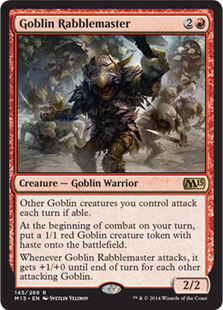 As for strengths, Goblin Rabblemaster boasts a decent Tron matchup compared with TURBOGOYF. In that matchup, Abzan Moon fared the best of all my versions, since Siege Rhino applies a lot of pressure and we aim to race Tron's Wurmcoil Engines. RabbleRit's namesake Goblin comes down sooner than Rhino and ends games more quickly than Tron can handle. Chalice of the Void turns off a huge chunk of Tron's searching power, such as Chromatic Sphere and Ancient Stirrings, rendering them too land-light to overcome Blood Moon with land drops alone. Chalice even proactively turns off Pyroclasm, if our mana permits. Finally, Ajani Vengeant serves as a Time Walk early on as Tron players reach for six mana, and a free "attack" with his -2 to close out games later.
As for strengths, Goblin Rabblemaster boasts a decent Tron matchup compared with TURBOGOYF. In that matchup, Abzan Moon fared the best of all my versions, since Siege Rhino applies a lot of pressure and we aim to race Tron's Wurmcoil Engines. RabbleRit's namesake Goblin comes down sooner than Rhino and ends games more quickly than Tron can handle. Chalice of the Void turns off a huge chunk of Tron's searching power, such as Chromatic Sphere and Ancient Stirrings, rendering them too land-light to overcome Blood Moon with land drops alone. Chalice even proactively turns off Pyroclasm, if our mana permits. Finally, Ajani Vengeant serves as a Time Walk early on as Tron players reach for six mana, and a free "attack" with his -2 to close out games later.
Without Birds in the deck, we can fearlessly play red's most versatile sweeper, Anger of the Gods. But RabbleRit's most obvious strength is the amount of games an early Chalice secures against certain decks. Infect, Living End, Affinity, Burn, and Delver of all flavors have an extremely hard time beating this card.
Locking It Up
We haven't seen Chalice of the Void make waves in Modern since Treasure Cruise was legal, but as long as the format favors linear decks full of one-drops, the card should always have a home in a shell that builds around it and ignores its restrictions. Adrian Sullivan's success with Obliterator Rock from Treasure Cruise-era Modern is a great example of what a Chalice deck can do in the right metagame. Conversely, the more a meta shifts away from decks like Treasure Cruise Delver and towards splashy midrange strategies, the better positioned Abzan Moon becomes.
It doesn't bode well for RabbleRit's development that while writing this article, I dug up (and sleeved up) my Siege Rhinos from last summer; in other words, I might not work on the deck for awhile to come. Still, I can see a home for RabbleRit in Modern eventually. And even if the deck never ends up as competitive as I predict, who doesn't want to be "that guy" at the LGS?


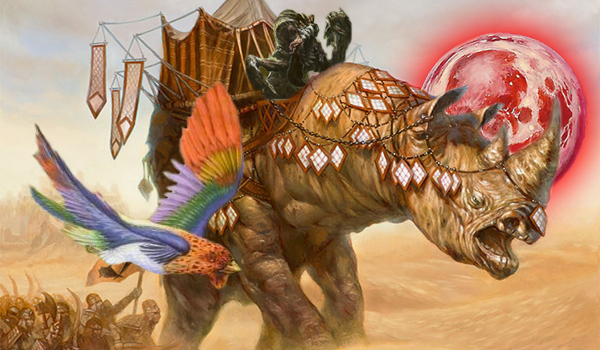



I don’t want to knock it until I’ve tried it, but you did just suggest a 4 colour deck with 4 blood moons in the main. This does not pass the sniff test as being a great plan :/
The rabble deck – the 4 rituals won’t help you cast chalice, is it really worth playing 6 cards that are pretty much completely dead in any situation other than turn 2 blood moon? The card disadvantage of the spirit guides seems ok because drawing one can enable either t1 chalice or t2 moon, you only have 4 so shouldn’t draw too many multiples, and finally he’s a 2/2 beater or chump blocker as a topdeck. The rituals do like 1/4 of the same work…
There were “all in red” decks back in the day with seething song to power out turn 2 demigod of revenge and whatnot, but I don’t see this as doing anything that crazy with stacked rituals since your 4 drops all need another colour :/
Six Blood Moons, not four 😉
That’s okay, I know it looks really bizarre. I’ve had a lot of success with it. But if you can’t get past the paper, don’t sleeve it up!
On the Ritual deck: I considered Demigod, but decided he might be too clunky. Would really like a mid-game ritual sink though. I’m leaning towards Empty the Warrens.
In the next article the deck gonna become a regular BGx.
I usually enjoy your articles, but this one went off the rails when you were testing those big midrange decks. 6 Blood Moon effects while simultaneously attempting to casting Rhino? Too greedy. Far too greedy. I’d be interested in seeing the decklist for the Temur Turbogoyf deck that you flirted with, then abandoned: Savage Knuckleblade is a pet card of mine, and terrible matchup against Abrupt Decay be damned (or mitigated to some extent by Simic Charm), I’d like to see it get some shine time.
The Chalice/Rabblemaster based deck, on the other hand, looks a lot more promising. I feel like it could stand to have a few more basic lands (because 14 fetches is going to negate a lot of the goodwill that Chalice of the Void gets for you against aggro), but at least there I understand what you were going for there.
Well, in testing, the Siege Rhino deck was very good. So good that I played it all summer and won something like 10 boxes of Khans with it at side events! The Rabblemaster deck needs work. It can’t consistently beat a wide variety of decks. I usually appreciate your comments, too, but for this one it seems like you just focused on how the list “looks” and not at all on how it actually plays. Did you test it at all? The mana in Abzan Moon is phenomenal. I hardly even take any damage from my lands. How is it “too greedy” if I can consistently play Moon into Rhino without stumbling? To me, “greedy” means unreasonable.
Fair enough. Usually I take the time to sleeve up your creations and test them for a bit before I comment, but this time I didn’t have the chance to. I’ll try out Abzan Moon and see if it runs smoother than it looks.
Some things to remember:
– To make the right mana, look at the fetches in hand. Say you have a Catacombs, a Sprawl, a Windswept Heath, and a Foothills. You crack the Foothills right away for Forest and put Sprawl on it, then name black (if you didn’t have Heath in hand, you might name white). Next turn you can fetch a shock and play Blood Moon, and then you just have to find a white source for Rhino (the only card in the deck that requires white mana). With Birds instead of Sprawl, everything gets much easier, since you can fetch a Swamp or Plains on turn 2 and play Moon with red from the Birds. Next turn, you can play Rhino.
– Against some decks, i.e. ones with Path and no basic white source, it’s imperative to slam the Moon before committing threats, even if they’re pressuring you. There’s no point in playing a Goyf that will just get removed and then eating more damage and watching your opponent increase his board with something like Smiter that you could have prevented.
– Save in hand any mana sources beyond 4 unless you’re playing around Leak (and have a good reason to). Same with Moons. That way, Looting draws you four cards when you get to it, and generally finds you either a handful of threats or more Lootings or both.
GL!
I was brewing a very similar list with turn 2 blood moons. Was just wondering why there seems to be no Choke in any of your lists? you are green red correct? i would expect this card for the sideboard as it wrecks a lot of blue decks who don’t construct their deck correctly, i have had to rebuild all my blue decks to consider this evil card.
Also, what is your view on Flashfires in the sideboard? I find mono white decks a pain and this helps.
I tried Choke in the initial “I’ll-start-with-this” sideboard, and quickly cut it because it didn’t address any specific problems this deck had. That’s what sideboard cards are supposed to do. There are no shoe-ins for a specific color combination (i.e. GR decks must run Choke). Huntmaster beats the white decks in my experience so I never needed Flashfires. Assuming you’re referring to Soul Sisters, I also don’t think I’d want that effect in that matchup, especially not for four mana. Their curve is low enough that they can recover easily, not to mention I’d lose my own Plains.
If you’re struggling to beat decks like mono-white control with this deck, then yes, play Flashfires. But I’m not having that problem.
Reading how these perform just makes me sad that I don’t have goyfs. I just love main deck blood moon and will sleeve anything up that has it.